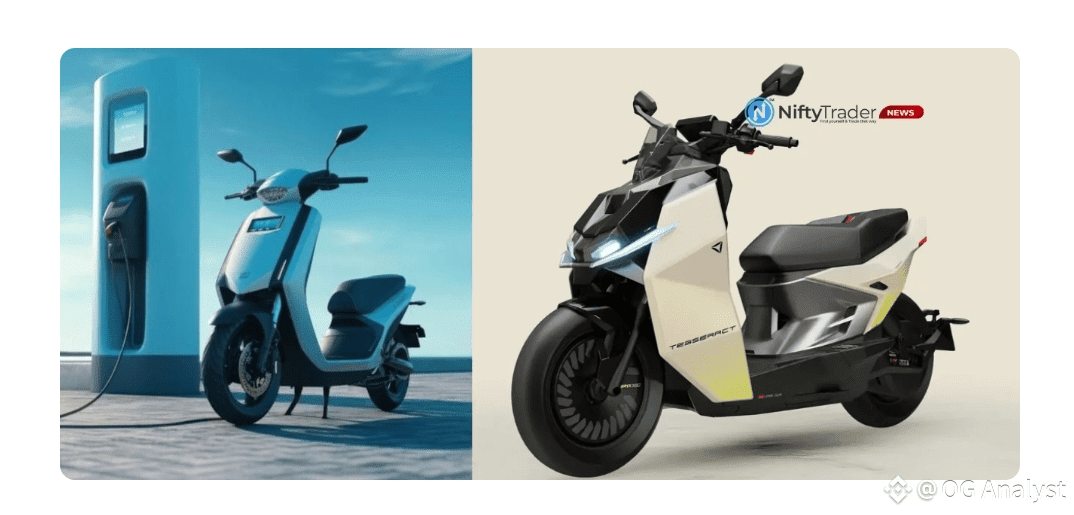India’s electric two-wheeler landscape witnessed a defining shift in October 2025, as Bajaj Auto surged ahead to claim the top position in monthly sales for the first time. Fueled by festive enthusiasm, strategic cashback offers, and new model rollouts, the company recorded its strongest-ever monthly performance. Data from the government’s Vahan portal revealed that Bajaj sold 29,597 electric scooters during the month, capturing a 21.9% market share — a clear signal of the brand’s accelerating influence in the electric mobility segment.

Close behind, TVS Motor Company sold 28,008 units, securing a 20.7% share of the market, while Ather Energy achieved a record-breaking 26,713 units, translating to a 19.6% share. In contrast, Ola Electric, once the unchallenged leader of India’s EV two-wheeler space, continued to lose ground. With 15,481 units sold and an 11.6% market share, the company slipped to fourth place for the second consecutive month — highlighting an increasingly competitive and maturing industry.
A Milestone Month for India’s EV Ecosystem
October marked a turning point not just for individual manufacturers but for the broader EV ecosystem. Total electric vehicle registrations across all categories touched 2.04 lakh units, marking an 11% sequential increase after two months of slowdown. Analysts attribute this rebound to a blend of seasonal demand, manufacturer-led incentives, and improved financing options that made EVs more accessible to a wider audience.
In September, India’s electric two-wheeler segment had registered 96,031 units, with TVS leading the pack, followed by Bajaj, Ather, and Ola. The jump in October reflects renewed consumer sentiment and stronger market momentum heading into the final quarter of 2025 — a period often seen as a bellwether for annual growth trends.
Festive Demand and Financing Fuel the Surge
The October boom was largely shaped by strategic festive campaigns. Bajaj Auto’s Chetak Urbane and Premium models found strong traction thanks to cashback incentives and low down-payment plans that appealed to first-time EV buyers. TVS Motor maintained its upward trajectory with consistent product availability and a rapidly expanding dealership footprint in major cities.
Ather Energy, meanwhile, leveraged its new 450 Apex variant and an expanding charging grid to inspire confidence among consumers focused on long-term usability. Analysts note that this combination of product innovation, financing accessibility, and after-sales assurance has been crucial in nurturing sustainable growth in India’s electric mobility journey.
Ola Electric’s Slide and the Rise of Legacy Networks
Ola Electric’s recent dip underscores a broader shift in consumer expectations. The company, once synonymous with India’s EV revolution, now faces intensified competition from legacy automakers that bring decades of dealership experience and customer trust. While Ola continues to hold significant market presence, the growing preference for in-person service centers and physical buying experiences has tilted the balance toward companies like Bajaj and TVS.
This dynamic illustrates the evolving nature of the EV market — where technological novelty alone is no longer enough. As the sector matures, network strength, service reliability, and brand familiarity are emerging as decisive factors in consumer choice.
Ather’s Breakout Moment
Ather Energy’s record-breaking month of 26,713 units stands as one of October’s defining achievements. Through a focused approach that combined aggressive retail expansion, targeted marketing, and investment in charging infrastructure, Ather positioned itself as a credible challenger in the top tier of India’s EV landscape. With nearly one-fifth of the market now under its belt, the company’s trajectory suggests continued growth in the quarters ahead.
Sustaining the Momentum
While November may bring a natural tapering of demand following the festive highs, the overall market outlook remains optimistic. Analysts point to several structural factors that could sustain momentum — including upcoming product launches, localized component manufacturing, and ongoing government incentives under the FAME-II policy framework.
Industry experts believe that India’s electric two-wheeler segment has entered a new phase of evolution. Competitive differentiation is gradually shifting from pricing battles to innovation, user experience, and ecosystem readiness. For Bajaj, TVS, Ather, and Ola — who collectively account for more than 70% of the market — the coming months will test not only their ability to scale production but also to sustain consumer confidence through service quality and infrastructure reliability.
In many ways, October 2025 may be remembered as the month India’s electric mobility story turned a corner — from early adoption to mainstream momentum, where performance, reliability, and trust began to drive the next wave of growth.


